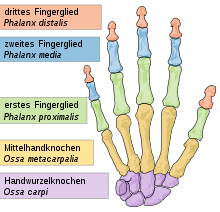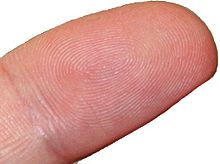Finger
![]()
The title of this article is ambiguous. For other meanings, see Finger (disambiguation).
A finger - scientifically also Digitus manus (plural: Digiti manus) - is a part of the hand. Fingers belong to the acra. A finger in humans has three bony supporting elements, the phalanges with phalanx proximalis, media and distalis, proximal, middle and distal phalanx, only the thumb has only two phalanges (phalanges; from the Greek word phalanx for battle line of warriors; plural: phalanges). The phalanges are articulated in the metacarpophalangeal and distal joints and connect with the metacarpophalangeal joint of the finger to the corresponding metacarpal bone (ossa metacarpi). In humans, the thumb occupies a special position, since its articulated suspension allows it to be in opposition to the other fingers. The movement of the fingers and the phalanges is effected by the tendons of the muscles in the area of the forearm ("extrinsic musculature") and the metacarpus ("intrinsic musculature"), the fingers themselves have no muscles.
Almost all tetrapods have five fingers (pentadactyl system). In the "beginning" the fingers are still connected by skins - the so-called interdigital skins (in animals: webs). Only with the regression of these interdigital skins through apoptosis do the fingers acquire their "free-standing" form. If this does not take place, cutaneous syndactyly occurs.
Fingers, in addition to gripping, supporting and holding, also have gestural functions, for example, thumb pointing upwards or downwards, extended middle finger, touching the thumb with the index finger, throwing finger and so on. The counterpart to the fingers are the toes on the lower extremities.

Finger bones (green, blue and pink)
Human finger
Typically, humans have five fingers on each hand in the following sequence:
- Thumb (Pollex; two-limbed)
- Index finger
- Middle finger (Digitus medius)
- Ring finger (Digitus anularis)
- Little finger (Digitus minimus)
Fingertip
The end of each finger is called the fingertip or fingertip berry. The papillary ridges on the undersides of the fingertips produce an individual fingerprint that can be used for personal identification (dactyloscopy). There are about 700 touch and pressure receptors in each fingertip. The fingertip is the name given to the terminal tactile pad at the end of the inside of each finger. This area is heavily supplied with blood and has many sensory neurons for touch. The fingertip, along with the earlobe, is a good site for drawing small amounts of blood. Each finger has a fingernail on the top of the fingertip.

Fingertip
Search within the encyclopedia